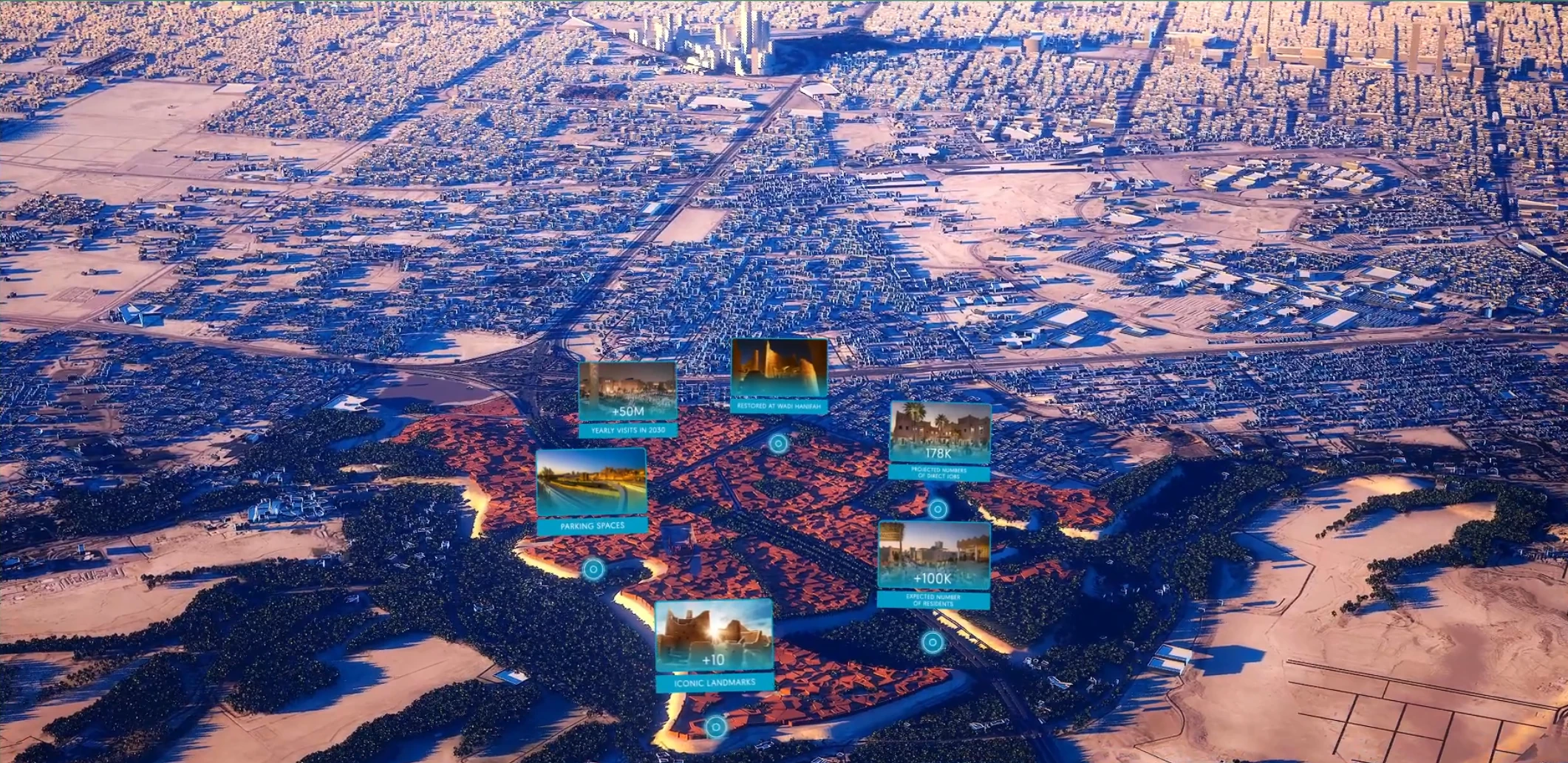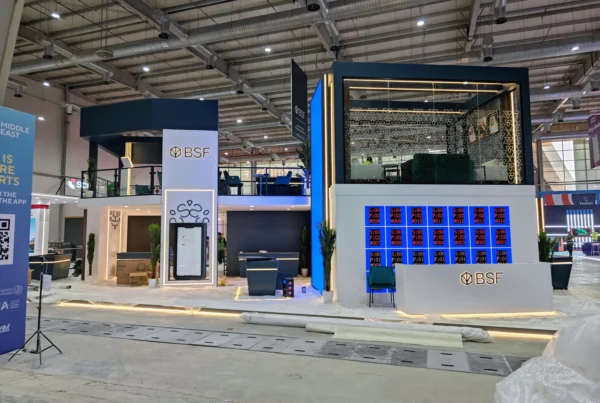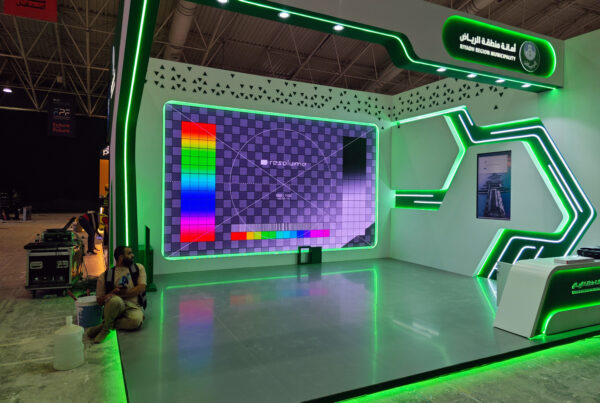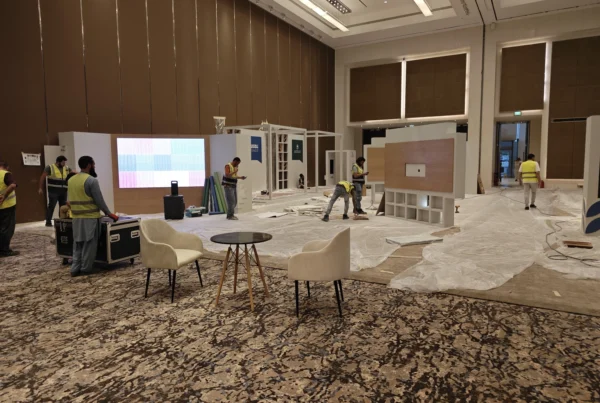The Gulf Cooperation Council (GCC) region—encompassing Saudi Arabia, the UAE, Qatar, Kuwait, Bahrain, and Oman—has witnessed an unprecedented construction surge over the past decade. Driven by economic diversification, population growth, and infrastructure ambitions, mega-projects now populate skylines from Riyadh to Dubai, sparking challenges such as compressed timelines, budget constraints, and multi-stakeholder coordination. As these large-scale developments race ahead, digital twin technology emerges as a powerful tool to minimize risk and reduce delays.
In this article, we’ll examine five ways digital twins help streamline GCC construction projects, from proactively identifying issues to providing real-time data transparency. Along the way, we’ll showcase examples from advanced real estate marketing to large-scale infrastructure, highlighting how integrating data-driven modeling transforms how teams design, build, and manage complex developments.

1. GCC Region Construction Boom: An Overview
1.1 Driving Forces Behind the Gulf’s Rapid Growth
Over the past few years, the GCC region has devoted extensive resources to construction and development, fueled by:
- Economic Diversification: Countries like Saudi Arabia aim to shift from hydrocarbon dependence to new sectors—hospitality, tech, healthcare, etc. Mega-projects like NEOM underscore this push.
- Population Increase & Urban Migration: The influx of residents into major Gulf cities spurs demand for housing, commercial spaces, and public facilities.
- Visionary Projects & Global Events: Initiatives such as Expo 2020 (Dubai) or major sports events require high-quality infrastructure, leading to aggressive timelines and elaborate building efforts.
While this robust pipeline of projects signals opportunity, it also brings complexities: supply chain disruptions, regulatory codes, multi-national contractors, and a climate that tests materials and logistics. Hence the need for efficient project management solutions that can keep up with these demanding conditions.
1.2 Challenges in Large-Scale GCC Projects
Despite the region’s construction prowess, project managers often encounter:
- Tight Schedules: Government-backed or private mega-projects regularly feature compressed timelines, leaving little room for error.
- Budget Overruns: Changes in design or unforeseen site issues can inflate costs, especially when attempting advanced features or LEED certifications.
- Collaborative Hurdles: International contractors and multiple subcontractors must align on architecture, engineering, and operations, often across multiple languages and time zones.
- Sustainability & Climate: The GCC’s harsh temperatures prompt advanced cooling and shading solutions, which must be validated for occupant comfort.
Enter digital twin approaches: living, data-driven models that adapt to actual conditions, bridging design, engineering, and operational data in a unified environment.
2. Understanding Digital Twins in a Construction Context
2.1 How Digital Twins Differ from Traditional 3D Models
While typical 3D models or BIM files depict structures visually, a digital twin integrates sensor feeds and real-time analytics, offering a constantly updated “mirror” of the physical building. For instance, occupant flow patterns or energy usage metrics can instantly inform design adjustments or scheduling modifications. According to Avoiding Growing Pains in the Development and Use of Digital Twins, carefully planning these data pipelines is essential to yield accurate, actionable insights.
Unlike static renders, digital twins remain relevant after a building’s completion, continuing to supply facility managers with data that helps refine ongoing usage. Real-time engines like Unity or Unreal Engine support detailed 3D representations, while behind-the-scenes IoT devices feed occupant or environmental data. This holistic approach transforms a visual concept into a continuously evolving reference point for everyone involved.
2.2 Adoption Across GCC Infrastructure
Although digital twins first gained traction in high-tech architecture or manufacturing, they now see broader uptake:
- Urban Planning: GCC cities integrate digital twins to map roads, utilities, and future expansions—improving zoning decisions.
- Defense Infrastructure: As discussed in “Tech is Game-Changer for Defence Infrastructure,” data-driven modeling helps track site progress, control costs, and ensure schedule adherence.
- Cultural Preservation: The “Vatican and Microsoft Create AI-Generated St. Peter’s Basilica” project exemplifies how digital twins document and manage historical assets—an approach the GCC can replicate for its heritage sites.
3. Five Ways Digital Twins Minimize Risk and Delay
3.1 Way #1: Enhanced Risk Identification Through Real-Time Data
One of the foremost advantages of digital twins is the continuous feed of sensor data—be it structural strain gauges, temperature logs, or resource usage. For GCC developers contending with large sites, this immediate visibility means:
- Proactive Alerts: If structural shifts or temperature spikes exceed thresholds, the digital model flags it immediately, prompting early intervention.
- Predictive Maintenance: Teams can anticipate equipment breakdowns or abnormal foundation loads before they escalate into costlier problems.
- Progress Verification: By overlaying sensor data onto the digital blueprint, project managers confirm that each phase is truly on schedule.
In contrast, conventional 3D models can’t reflect real-time anomalies, leaving teams reliant on manual site inspections or monthly progress reports, which may be too late to avoid major disruptions.
3.2 Way #2: Collaborative Scheduling & Coordination
The GCC region’s large-scale projects often bring multiple subcontractors, each handling specialized tasks—formwork, steel reinforcement, mechanical installations, etc. Without a single source of truth, scheduling mix-ups arise, causing site congestion or supply chain friction. Digital twins unify:
- Unified Scheduling: Subcontractors see a single, real-time plan that updates automatically if a prior phase faces a delay.
- Coordination Tools: AR-based solutions integrated with the twin might visually highlight “zones” in need of specific trades, clarifying daily or weekly tasks.
- Cross-Border Collaboration: Where designers or consultants work remotely, the digital twin environment fosters live design sessions, bridging time zones and eliminating guesswork.
As a result, everyone from local site foremen to international consultants can adapt swiftly, curbing typical “waiting” overhead or confusion that often plagues massive Gulf projects.
3.3 Way #3: Proactive Delay Minimization via Predictive Analytics
Delays loom large in any construction venture, especially in the Gulf’s multi-stakeholder environment. Digital twins harness AI-based predictive analytics to foresee obstacles:
- Supply Chain Forecasts: The system might project shipping issues or material scarcities, prompting alternative sourcing.
- Weather Integration: Using local climate data, digital twins can reschedule tasks that rely on moderate temperatures or minimal sandstorms, maximizing productive windows.
- Scenario Testing: If a subcontractor faces labor shortages, project managers can run “what-if” simulations to see how timeline adjustments mitigate knock-on effects.
By enumerating probable outcomes, digital twins limit panic over last-minute curveballs, crucial in high-profile GCC developments that typically have no tolerance for major slippage.
3.4 Way #4: Cost Control and Resource Optimization
Where a standard 3D model is passively aesthetic, a digital twin actively tracks resource usage, potentially linking into on-site inventory systems to show exact material consumption. For the Gulf’s cost-intensive projects:
- Transparent Budgeting: Investors and owners gain real-time cost glimpses, from labor hour consumption to how many concrete batches remain.
- Energy Efficiency: In a harsh climate, cooling infrastructure is vital. A digital twin can highlight temperature zones, occupant loads, and energy spikes—leading to precise HVAC calibrations.
- Early Clash Detection: The system automatically flags design collisions or overlapping tasks, preempting rework that inflates budgets.
For marketing-luxury developments or large-scale commercial towers, controlling overhead builds trust with lenders, governments, and end-users alike—especially if the project must stay within a set timeline for events or public rollouts.
3.5 Way #5: Greater Transparency for Stakeholders
GCC construction often involves multiple layers of oversight—from municipal authorities to foreign JV partners. A digital twin’s live dashboard fosters:
- Unified Monitoring: Government officials, project owners, or investor consortia can log in to track site progress and address bottlenecks collaboratively.
- Enhanced Communication: Visualizing complex engineering details in an accessible, data-driven model clarifies decisions for non-technical stakeholders.
- Immersive Showcases: Building a sense of shared excitement—similar to Immersive Interactive Technology for Events—digital twins provide a compelling means to present milestones or new phases at press events.
In essence, data-driven clarity reduces speculation and suspicion, forging stronger alliances among architects, contractors, and clients—a crucial factor in the success of large GCC projects.
4. Real-World Examples in the GCC
4.1 Adopting Digital Twins for Mega-Developments
Saudi Arabia’s push for Vision 2030 includes multi-billion-dollar cities like NEOM, where advanced modeling and analytics presumably accelerate progress. Although official references may be limited, the trend suggests that digital twin platforms play a major role in verifying schedules, aligning contractors, and presenting real-time updates to government bodies or private investors.
4.2 Projects Showcased in Riyadh and Jeddah
Examples like the Riyadh Digital Twin: A New Dimension in Urban Visualization and the Jeddah Central Development Company Digital Twin Project reveal how 3D artistry and VR/AR immersion fuse with data feeds. These local showcases exemplify collaborative synergy—urban planners, engineers, and marketing teams collectively benefit from accurate site reflections.
4.3 Linking to Wider Global Precedents
Although the GCC has its unique environment, the region can draw lessons from global digital twin success stories:
- Defense Infrastructure: As described in “Tech is Game-Changer for Defence Infrastructure,” real-time modeling speeds up schedules and fosters cost reliability for large, sensitive projects.
- Cultural Preservation: The Vatican’s AI-based digital twin of St. Peter’s Basilica resonates with potential Gulf applications, preserving heritage sites or religious landmarks while making them virtually accessible.
In each scenario, the consistent thread is improved collaboration, transparency, and time-to-market—a trifecta extremely pertinent to the GCC.

5. Implementation Challenges and Best Practices
5.1 Data Governance & Security
Collecting occupant metrics or structural data triggers privacy and security obligations. Basic measures include:
- Encryption of sensor transmissions,
- Permission-based access for staff and external vendors,
- Clear disclaimers about data usage for commercial or occupant analytics.
Integrating large teams demands even more robust frameworks, ensuring sensitive intelligence (like interior footage or occupant patterns) remains protected.
5.2 Skilled Workforce and Training
Adopting digital twins calls for bridging traditional construction roles with advanced tech—like data scientists or IoT integration experts. That shift can be daunting for local firms reliant on older project management methods. A structured training approach helps teams grasp real-time dashboards or AR modules, maximizing the technology’s potential.
5.3 Gradual, Pilot-Oriented Rollouts
Tackling an entire 100-building complex at once is risky. More prudent is to pilot digital twin adoption on a smaller block or subsystem—like an HVAC segment—gathering ROI data. If the pilot proves successful, management can scale up with confidence, refining the approach for more intricate tasks.
6. Future Outlook: Digital Twins Transforming GCC Construction
6.1 AI-Enabled Adaptations
As digital twin data sets grow, machine learning can propose daily schedule shifts, temperature configurations, or occupant flow optimizations. Over time, these insights might automate entire segments of the building environment, from adjusting lights to rearranging tasks in response to real-time logistics updates.
6.2 Persistent Virtual Worlds for Stakeholder Coordination
Developers might host ongoing VR “rooms” or AR layers where remote stakeholders—government agencies, foreign investors—log in to watch progress or discuss changes. This environment parallels “metaverse” concepts but is firmly tied to real, physical building data.
6.3 Expanding Partnerships Across the Region
Given the scale and complexity of GCC projects, we could see integrated digital twin platforms that unify multiple developments—like entire city districts under a single vantage. Collaboration among states or major entities fosters knowledge-sharing, further accelerating technology adoption and standardization.
Conclusion
In the GCC region, where large-scale construction projects define the skyline, digital twin technology offers a clear route to minimize risk and cut delays. From real-time risk detection and collaborative scheduling to cost control and stakeholder transparency, data-driven modeling addresses the complexities unique to the Gulf’s market and climate.
To move forward:
- Assess Your Priorities: Whether your biggest concern is scheduling or occupant satisfaction, define how digital twins can advance your goals.
- Start with a Pilot: Incorporate sensor data and real-time rendering engines in a single pilot building or key subsystem.
- Invest in Training: Ensure local teams understand how to interpret twin analytics, bridging existing knowledge gaps.
- Leverage Immersive Features: Rethink product launches, investor updates, or facility oversight as event-like experiences—similar to Immersive Interactive Technology for Events—boosting engagement.
As you explore the potential for data-driven design and building management in the GCC environment, consider resources like Digital Twin Buildings vs. Traditional 3D Models: Key Differences and Benefits or reach out to us via اتصل بنا at Chameleon Interactive. By harnessing real-time insights and interactive visualization, you’ll remain ahead in an increasingly competitive construction landscape, delivering timely, cost-effective, and future-ready projects that align with the Gulf’s ambitious horizons.
FAQ: Digital Twins in GCC Construction—Minimizing Risk and Delay
1. What makes digital twin technology different from a standard 3D model for GCC projects?
A digital twin continuously integrates real-time data—like sensor feedback and occupant metrics—into a dynamic 3D environment, while a conventional 3D model remains static and doesn’t reflect ongoing changes. This real-time aspect is pivotal in the fast-paced GCC construction market, where rapid iteration and adaptation often determine project success.
2. How do digital twins help avoid delays in large-scale Gulf developments?
By gathering immediate status updates from construction sites, digital twins highlight any scheduling conflicts or material shortages before they escalate, enabling swift remedial action. Predictive analytics can also forecast disruptions based on local factors like climate and supply chain constraints, minimizing unplanned downtime.
3. Can digital twin solutions benefit building operations after project completion?
Yes. Even after a structure is finished, digital twins remain valuable for facility management—tracking energy consumption, occupant flow, and maintenance requirements in real time. This proactive approach leads to cost savings, greater sustainability, and enhanced occupant comfort—aligning with the region’s push for modern, efficient development.
4. Are there any particular security or data privacy concerns when using digital twins in the GCC?
Yes. Real-time data often includes sensitive operational and occupant information, so project teams must implement encryption, role-based access controls, and clear protocols for handling data. Maintaining transparency around data usage fosters trust among stakeholders, including government agencies and international partners.
5. What steps should GCC firms take to adopt digital twin technology effectively?
Start with a pilot project—perhaps one building or subsystem—to gather ROI data and work out potential challenges. Next, choose a suitable real-time engine (such as Unity or Unreal Engine) and assemble a multidisciplinary team (engineers, data scientists, IoT experts). Ongoing training, stakeholder collaboration, and a clear roadmap for scaling the digital twin to other projects are all essential for long-term success.


